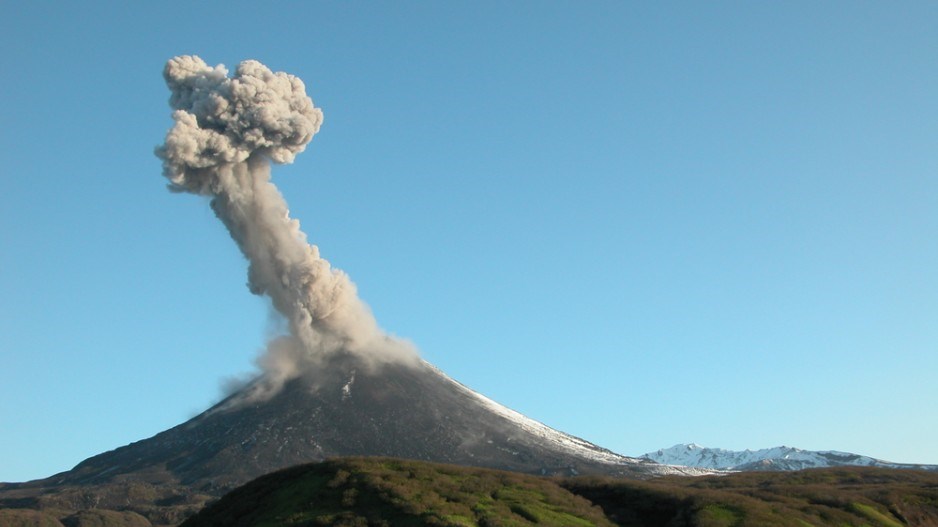In 2009, the Fraser River sockeye run dipped so low – 1.7 million – that it was characterized as a collapse and triggered the Cohen Commission inquiry.
But the year the inquiry was held – 2010 – fisheries scientists were shocked when 28 million sockeye returned to the Fraser River.
What got lost in 2009 was that, although sockeye returns were nearly 10 times lower than forecast, pink salmon returns were 14% higher than expected (20 million), according to the Pacific Salmon Commission.
But 2010 wasn’t the only time Fraser River sockeye inexplicably spiked, exceeding forecasts.
It appears to happen every time there is a major volcanic eruption in the northern Pacific. The spikes happen two years after the eruptions, and sockeye are the salmon species that seems to be most affected.
Tim Parsons, a renowned and now retired fisheries scientist, theorized that the unusually high 2010 returns might have resulted from a 2008 volcanic eruption in Alaska.These eruptions dump huge amounts of iron into the Pacific, which acts as a fertilizer for phytoplankton. The blooms may be responsible for boosting salmon abundance two years on, Parsons theorized.
“We contend this increase in food availability was an important factor for the survival and growth of juvenile sockeye, which led to one of the strongest sockeye returns on record in 2010 of 34 million, compared with perhaps the weakest return on record of 1.7 million the previous year,” Parsons and Frank Whitney wrote in a 2012 paper.
Historical data from the North Pacific Anadromous Fish Commission appears to suggest a correlation between volcanoes and spikes in abundance of sockeye, but not other species.
That may be because sockeye spend more time in the Pacific Ocean, said retired fisheries scientist Carl Walters.
“Chinook and coho mostly stay near the coast and so are not influenced by things happening out in the open Pacific, and chums come back as mixed three- and four-year-olds such that the mixture obscures anything that might be happening in a cyclic way,” Walters wrote in an email to Business in Vancouver.
The 1988 Mount Reboubt eruption in Alaska is particularly interesting. It continued spewing ash for several months into 1989. Sockeye returns in Canada were unusually high for the six years following the eruption.
But the most interesting year is 2014, when roughly 25 million sockeye returned to B.C.
It is interesting because there was no major volcanic eruption in 2012 in the northern Pacific that might explain the spike.
There was, however, a rogue geoengineering experiment.
In 2012, a maverick American entrepreneur, Russ George, working with the Haida Nation, dumped 100 tonnes of iron into the ocean off Haida Gwaii.
The experiment was criticized for being unauthorized and irresponsible. A paper published in 2013 confirmed that the iron resulted in the largest phytoplankton blooms in that area in 10 years. Phytoplankton blooms can create zooplankton blooms.
Walters is on record as saying deliberate iron fertilization of the Pacific Ocean is a bad idea.
But he thinks it might be worth at least running another experiment – a more controlled one – to test the theory.
That might help explain salmon increases, but it wouldn’t explain decreases.
Walters believes one of the things that may be contributing to high salmon mortality is predation by mammals – particularly Steller’s sea lions.
“Some predators, Steller’s sea lions in particular, have increased dramatically, and a few of us suspect that they may be a much more serious problem than anyone suspected just a few years ago.”
B.C. sockeye increases coinciding with volcanic eruptions
Bezymianny: Kamchatka, Russia (1956)
1956 returns: 10.6 million
1957: 7.7 million
1958: 36.6 million
Mount St. Helens, Washington (1980)
1980 returns: 8.5 million
1981: 22.7 million
1982: 37.8 million
Mount Redoubt, Alaska (1988-89)
1988 returns: 12.9 million
1989: 37.3 million
1990: 40.3 million
1991: 27.4 million
1992: 22.6 million
1993 46 million
1994: 33.3 million
Kasatochi, Alaska (2008)
2008 returns: 1.8 million
2009: 600,000*
2010: 26.7 million
Geoengineering, Haida Gwaii (2012)
2012 returns: 2.2 million
2013: 800,000
2014: 24.7 million
Source: North Pacific Anadromous Fish Commission
*Note: Figures are for commercial catch, and does not represent total abundance
See related stories: Russian bear eats a lot of salmon.




